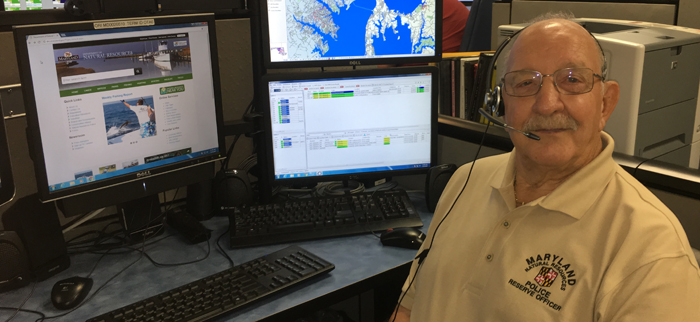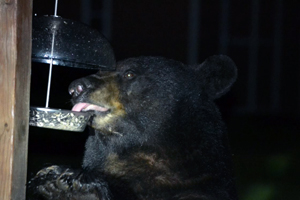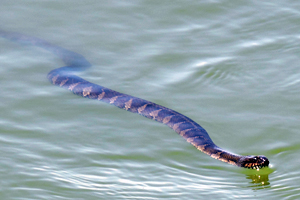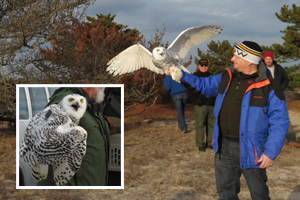Wildlife Calls: Reserve Officers relieve dispatch overload

Reserve Officer Campbell; department photo
When the phone rings at the Maryland Natural Resources Police communications center, a dispatcher has no idea whether it is a boater’s cry for help or a homeowner with a frog in their bathtub.
| In any wildlife encounter, safety is key and photos are not usually priorities. The images below illustrate what some calls may entail. |
Each caller deserves, and gets, prompt attention. But clearly there is a lot more at stake in an emergency.
To take the strain off the dispatchers, the Natural Resources Police has begun using volunteer reserve officers to answer the phones, handle general questions and basic wildlife complaints.
“It’s both a customer service improvement and a public safety upgrade,” says Sgt. Cameron Brown, who proposed the program. “If a dispatcher is handling an emergency, that person with a question about a fishing license is going to have to wait.
“We think this has the potential to let dispatchers focus on the urgent calls—especially in summer when every minute counts—and have the reserve officers assist in those non-emergency situations,” Brown says.

“There’s a bear in my bird feeder! What should I do?” Scare it away with loud noises, and be sure to take all food in at night. (photo by Sarah Milbourne)
Managing volume
The new setup mirrors what is used at larger police departments, where paid call takers act as middle men, directing phone traffic to the right person.
The idea surfaced in 2009, when the communications center moved from the basement of the Department of Natural Resources headquarters in Annapolis to a new facility near Sandy Point State Park.
“The idea impressed me,” recalls Reserve Officer Joe Campbell. “I jumped at the chance. I said I would like to help.”
Other projects took priority until earlier this year, when supervisors and commanders began looking for cost-efficient ways to meet growing public demand. Dispatchers, officially called police communications operators, handled 33,285 calls for service in 2016. With nearly 24,000 calls logged as of July 31, they are on pace to far surpass that total in 2017. A team of 24 dispatchers handles those calls, 24/7.
Tools and training
Right now, three reserve officers are helping out, sitting at the row of desks behind the dispatchers’ consoles. They are getting a lot of the same entry-level training as dispatchers: learning geography, patrol areas, and the missions of the department and police.

“I thought we didn’t have water moccasins in Maryland! What’s this?” We don’t. This is a northern water snake, which isn’t venomous, but isn’t friendly either. (photo by Stephanie Kendall)
Sgt. Murray Hunt, who supervises the dispatching team, devised PowerPoint lessons so that the trainees could study at home before they received training in the communications center.
After receiving the basics, the reserve officers were taught where to find answers: hunting and fishing guides, official government websites, tide charts, state natural resources law books.
Dispatcher Michael Barr customized the list of wildlife trappers and rehabilitators to include the territory to which each is willing to respond.
“The training was thorough and gave us confidence,” says Campbell, 71, who worked for the U.S. Postal Service and as an electrician before his retirement. “Sgt. Hunt really has it together. He is bringing us along gradually, adding duties as we master each level.”
For now that means tackling wildlife calls. On a recent day, the calls ranged from reports of a possible rabid fox near an Anne Arundel County playground to a seemingly abandoned fawn near Bowie in Prince George’s County and a bald eagle injured by a passing vehicle in Allegany County.

“I found my dog playing with a turtle! Will he be ok?” Turtles do carry salmonella, so be mindful even if your home houses both pets. Also remember your dog may hurt a turtle’s all-important shell while playing, even if he’s more playful than aggressive. (photo by Jenna Kerr)
No such thing as typical
Some callers are merely seeking a phone number or an online resource so that they can handle a simple issue by themselves. Others have a more challenging problem that requires the attention of a member of the wildlife response team. But sometimes, only a visit by an officer will do. Before the reserve officers joined the team, it fell to a dispatcher to address each concern while juggling other duties.
“These calls just take time,” says Hunt. “Sometimes, they take even more time than other types of calls because people are frightened or shaken.”
Wildlife calls are no small part of a dispatch shift. Last year, officers responded to 1,393 wildlife calls, but the number of requests handled by dispatchers “was probably triple that,” says Hunt. “Having trained reserve officers peel off the non-emergency requests balances the workload.”
Add to that mix a fair number of totally off-the-wall inquiries. Recent satirical social media posts claiming state officials were going to drain large bodies of water for cleaning created an uptick in calls, increasing the amount of work for dispatchers. While funny at first, the joke quickly lost its charm.
“Oh, boy,” says Hunt, shaking his head and rolling his eyes at the memory.
Diverse backgrounds aid customers
Several reserve officers bring to the communications center outside experience that brings another dimension to their shifts. For example, Kirk Gardner, 51, has helped out at the Maryland State Police barrack in Glen Burnie for 11 years. An avid hunter, he also has been a taxidermist and a commercial crabber.

Sometimes calls have great endings. After this snowy owl was found with an injured wing, wildlife experts rehabilitated and later released her at Assateague. (photo by Stephen Badger)
“I’m an outdoors person. I can put myself in the caller’s shoes, spend some time with them and talk them through a situation,” Gardner says. “I love it. You can really feel like you’re making a contribution.”
Seven other reserve officers are being trained. It is hoped that they will be able to expand coverage to Thursday through Sunday, when the phone traffic is the heaviest.
“Right now, while they’re learning, the dispatchers are their wing men if they get in a bind,” says Hunt.
“But when we get better,” says Campbell, with a smile, “we will be their wing men.”
Article by Candy Thomson—Natural Resources Police public information officer.
Appears in Vol. 20, No. 4 of the Maryland Natural Resource magazine, fall 2017.


 1-888-373-7888
1-888-373-7888 233733
233733